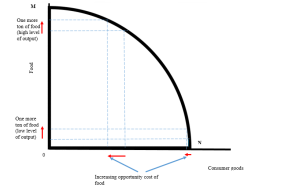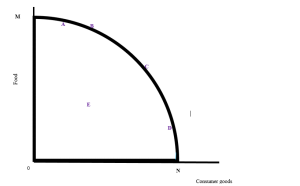Production Possibility Frontier
The production possibility frontier, sometimes referred to as the production possibility curve, is a way of understanding the basic economic problem of infinite wants and scarce resources.
All societies have to make decisions about how resources are combined and what they are used to produce. The choices that have to be made are:
• What to produce?
• How to produce?
• For whom to produce?
The Purpose of Production Possibility Frontiers
Production possibility frontiers can be used to explain and illustrate key principles, such as choice, opportunity costs, equity and efficiency. Production possibility frontiers are drawn on the basis of a number of assumptions:
1. Resources are used to produce a combination of two possible goods.
2. The quantity of resources used does not change.
3. Technology and techniques for production will not change.
4. Resources will be used in a way which is technically efficient.
The diagram below illustrates the production of two goods. In this example, a choice must be made between producing food or consumer goods, or some combination of the two goods.

If more food is produced then production of consumer goods must be sacrificed. This has to happen because resources are scarce, resulting in an opportunity cost. More food can be produced with the resources available in an economy but only at the expense the production of consumer goods.
The production possibility curve is convex because as we increase output of one good the opportunity cost of the other good increases. As we produce each extra ton of food we sacrifice more consumer goods as we switch resources from producing consumer goods to producing food, they are increasingly less suited to the production of food and increasingly more suited to producing consumer goods.
Economic is about rational decision making and making the best use of resources. This means that it is important that inputs should be used effectively in order to produce as much output as possible.
Economists use two key measures of efficiency, they are technical efficiency and allocative efficiency. Technical efficiency is also referred to as productive efficiency. Technical efficiency occurs the output of goods and services is maximised and resource costs are minimised.
Allocative efficiency, is also sometimes referred to as Pareto efficiency after Vilfredo Pareto, Sociologist, Economist, engineer and director of Italian railways. Allocative efficiency occurs when an additional unit of one good can only be produced at the expense of the production of another good. Put another way, it is only possible to make one group of consumers or producers better off if another group of producers or consumers is made worse off.
Efficiency and inefficiency
The diagram below shows a number of points which are productively efficient

Points A, B, C, and D are all productively efficient. Points A, B, C and D are also allocatively efficient. Governments could choose any combination of goods all on the production possibility frontier and they would be both allocatively efficient and productively efficient. The combination of goods chosen to be produced by the country will depend upon the priorities of the government and what is considered to be equitable rather than considerations of efficiency. Society will have to decide whether they want to prioritise.
Point E would not be chosen by any rational government. Point E represents productive inefficiency since resources are not being in a way that optimises production. Indeed, any point within the production possibility frontier would be inefficient.
The choice on what quantity of food and what quantity of consumer goods to produce would not be made on the basis of economics but on the values and preferences of a particular society. Inevitably, this may mean that value judgements will affect decision making.